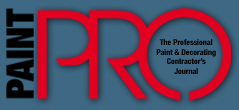Kelly-Moore Paint Company,
San Carlos, California
by Liz Trauring
who built an exceptional company. After 58 years at the helm of Kelly-Moore Paint Company, he passed away peacefully on November 21, 2004 at the age of 87 — an active voice and executive until the end.
Having gained some experience in the industry by working for Glidden before joining the Navy, Moore decided to start a paint company that would focus on the painting contractor, a revolutionary idea in 1946. He teamed up with William H. Kelly, who had retired from Glidden, and the two began to manufacture paint with the hopes of making about $3,000 a month — big money at that time. Kelly did the mixing and Moore did the selling and made deliveries, and at the end of six months they had made not $6,000, but $60,000. They had tapped into the booming, pent-up demand of the post-war California building boom that seemed to be centered in San Carlos. By selling directly to the contractor through its own stores, Kelly-Moore was able to price its products well and focus its service on this professional market. Moore always maintained that the stroke of marketing genius that made the stores such an instant success was to supply free coffee and open early so sleepy contractors could get their supplies (and coffee) and still be on the job on time. Today, Kelly-Moore is one of the largest independent, employee-owned paint companies in the United States, with 2,100 employees, 145 company-owned stores throughout eight western states and in Bill Moore’s home state of Arkansas, and four manufacturing facilities which produce nearly 20 million gallons of paint annually. According to Rod O’Neal, corporate product manager, having 42 percent of the company owned by employees in an Employee Stock Ownership Plan (ESOP) affects the way the company as a whole does business. “The better we service our customers, the better job we do of increasing sales, and the continued focus on manufacturing quality products will result in a stronger and more profitable Kelly-Moore Paint Company. Success in these areas will benefit all employees.” Herbert R. Giffins, president and CEO since January 2003, has every intention of continuing Kelly-Moore’s independence, fueling growth through new convenient locations, line extensions and value-added services to the contractor. Growth is also coming from business in China and the South Pacific. When the company began doing business abroad in 1998, it received its ISO certification, which “definitely has been good for Kelly-Moore,” O’Neal says. “Having to document procedures in order to adhere to international quality standards has been very helpful in guiding the company to greater growth and profitability.”
Headquartered in California, the Kelly-Moore Paint Company has been subject to the most stringent VOC regulations in the nation. Therefore, Kelly-Moore’s architectural coating product mix is approximately 90 percent waterborne and 10 percent solvent borne. Kelly-Moore’s R&D Laboratory is located at their San Carlos facility and supports all three of the company’s manufacturing plants.
Kelly-Moore definitely has had an advantage over companies that don’t manufacture in California, O’Neal says. “We have chemists who not only maintain quality control but develop products that keep the company ahead of California’s stringent VOC regulations. We will continue to look at new technologies that will help us formulate lower VOC products that will perform as well, if not better, than what is available in the market today. “There is no question that the paint industry has changed drastically over the past 15 years,” O’Neal says. “ For one thing, consolidation has substantially reduced the number of players. While Kelly-Moore is certainly concerned about this competition, its focus is to continue to build on its service to professional painting contractors and to manufacture quality products that meet their needs.” Kelly-Moore’s full line of products includes metal, wood, masonry, concrete and stucco exterior finishes as well as interior finishes for gypsum wallboard, plaster, concrete, masonry, wood, hardboard, ceiling and metal. Working to help San Bernadino County provide an environmentally responsible way to dispose of leftover latex paint, in 1993 Kelly-Moore developed E-Coat, a paint made with a minimum of 50 percent post-consumer recycled paint. Kelly-Moore’s Sacramento E-Coat Recycle Center is one of only a few of these types of operations in California. O’Neal says that this isn’t a major profit center, but is a responsible way of trying to protect the environment and provide a quality product for this category. “Without a doubt, water-based paint recycling is driven by federal, state and local agencies and will grow in the future as more states tighten their regulations,” he says. 
|

